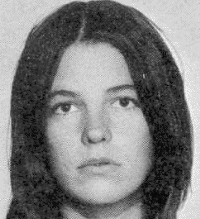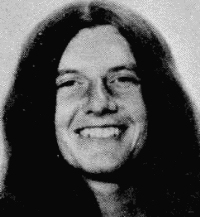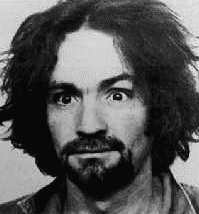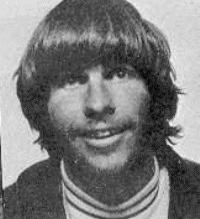Susan Atkins (aka Sadie Mae Glutz)

As a young teen, Susan Atkins sang in her church choir in San Jose, California and nursed her mother, who was dying of cancer. After her mother's death, however, her life went seriously off course. She fought with her father, dropped out of high school, and moved to San Francisco where she became a topless dancer, hustler, and gun moll.
While living in San Francisco's Haight-Ashbury district in 1967, Atkins met Charles Manson. In her grand jury testimony, Atkins said Manson "gave me the faith in myself to be able to know that I am a women....I gave myself to him." Atkins said there was "no limit" to what she would do for "the only complete man I have ever met." To Atkins, Manson "represented a Jesus Christ-like person."
Atkins spent a year-and-a-half traveling around the Southwest with other Manson Family members on an old school bus, taking lots of LSD, and practicing free love with Manson Family members of both sexes. In 1968, she bore a child, who Manson helped deliver, named Zezozose Zadfrack Glutz. Atkins moved into the Family's Spahn Ranch in 1969. On August 8 of that year, she obeyed Manson's order to join in the what would be the bloody attack that left five dead at the home of actress Sharon Tate. Atkins later admitted stabbing Voytek Frykowski and holding down Tate while she was stabbed repeatedly by Tex Watson. She also said she wrote "PIG" using Tate's blood on a door of the residence.
While being held on other charges in 1969, Atkins explained her decision to participate in the massacre at the Tate residence to another inmate, Virginia Graham: "You have to have real love in your heart to do this for people."
The LAPD proposed granting Atkins prosecutorial immunity in return for her testimony that could convict Manson and other Family members. Prosecutor Vincent Bugliosi objected, saying "We don't give that gal anything!" In the end, the prosecution offered not to seek the death penalty in return for her trial testimony--an offer which Atkins, after testifying before the Grand Jury, refused.
Atkins, then twenty-two, was convicted of first-degree murder and sentenced to death in 1970. Her sentence was reduced to life imprisonment when the California Supreme Court declared the state's death penalty unconstitutional.
Atkins continues to reside at this writing at the California Institution for Women in Frontero. In September 1974, Atkins said her cell door opened and "a brilliant light poured over her." Describing the experience in her 1977 book Child of Satan, Child of God, Atkins said she believed the light was Jesus, telling her she had been forgiven.
Although Atkins has had an exemplary prison record, she was never paroled and died of brain cancer on September 24, 2009. She was 61.

A psychiatrist, after evaluating Leslie Van Houten, described her as "a psychologically loaded gun which went off as a consequence of the complex intermeshing of highly unlikely and bizarre circumstances." The psychiatrist saw Van Houten as "a spoiled little princess" who, from childhood on, was impulsive, easily frustrated, and prone to displays of temper. She admitted, for example, to having beaten her adopted sister with
a shoe.
Although described as being the least committed to Manson of the three female defendants, Van Houten nonetheless agreed to participate in the murderous raid on the LaBianca home on August 10, 1969. She helped hold down Rosemary LaBianca while Tex Watson stabbed her to death. In a November 1969 interview with police, Van Houten admitted to knowledge of the Tate-LaBianca murders, but denied participation.
Van Houten's first attorney, Donald Barnett, was dismissed after crossing Manson. Her second lawyer, Marvin Part, wanted to show that Van Houten was "insane in a way that is almost science fiction." Part saw her crime as influenced by LSD and Charles Manson, but Van Houten saw it differently: "I was influenced by the war in Viet Nam and TV." At Manson's urging, Van Houten fired Part and yet another attorney was appointed. When Van Houten's third attorney, Ronald Hughes, also began pursuing a strategy that ran counter to that favored by Manson (Manson opposed any strategy that suggested the other defendants acted under his influence), the Family had him killed. No one has ever been charged with his murder.
Van Houten's first-degreee murder conviction in the Tate-LaBianca trial was overturned by a state appellate court in 1976 on the ground that Judge Older erred in not granting Van Houten's motion for a mistrial following the disappearance of attorney Ronald Hughes. In her first re-trial, the jury was unable to reach a verdict. Released on bond for a few months, Van Houten lived with a former writer for the Christian Science Monitor. She was tried a third time in 1978 and convicted of first-degree murder after the jury rejected her defense of diminished capacity as the result of prolonged use of hallucinogenic drugs.
In prison at the California Institution for Women , Van Houten accepted responsibility for her crime: "Being a follower does not excuse." She earned a degree from a correspondence school (with a major in English Lit), edited the prison paper, sewed for the homeless, and wrote short stories. Although no one could find fault with her prison record, she was denied parole in 2002. In 2016, the California Parole Board recommended parole for Van Houten, but Governor Jerry Brown, cognizant of the politics of the case, rejected the Board's recommendation and Van Houten remained in prison. Van Houten's life in prison is described in a recent book by Karlene Faith, The Long Prison Journey of Leslie Van Houten (2001).

In September 1967, twenty-year-old Patricia Krenwinkel joined the Family, leaving behind her Manhattan Beach apartment, her car, her job, and even her last paycheck. She joined many other Family members on a drug-and-sex-filled eighteen-month tour of the American West in an old school bus, before settling into Spahn ranch in 1969. At her sentencing, Krenwinkel idealized the Family's early days: "We were just like wood nymphs and wood creatures. We would run through the woods with flowers in our hair, and Charles would have a small flute."
In August 1969, Krenwinkel participated in the murders at the Tate and LaBianca residences. At the Tate home, Krenwinkel dragged Abigail Folger from her bedroom to the living room, fought with her, and stabbed her. Later she would say, "I stabbed her and I kept stabbing her." Asked about how it felt, she replied, "Nothing--I mean, what is there to describe? It was just there, and it was right." The next night, Krenwinkel stabbed Rosemary LaBianca and carved the word "WAR" on Leno LaBianca's stomach.
Krenwinkel was arrested near her aunt's home in Mobile, Alabama on December 1, 1969. Krenwinkel had gone to Alabama, she said much later, because she feared Manson would find her and kill her. In February, she waived extradition proceedings and voluntarily returned to California to stand trial with the other defendants. Her trial attorney, Paul Fitzgerald, offered only a weak defense. At one point, Fitzgerald suggested that although Krenwinkel's fingerprints were found inside the Tate home, she might just have been "an invited guest or friend." Krenwinkel spent much of the trial drawing doodles of devils and other satanic figures.
At the California Institution for Women in Frontero, Krenwinkel has been a model prisoner. She has, with Leslie Van Houten, counseled young drug offenders, completed a course in data processing, and played on the prison softball team. She has expressed deep remorse for her role in the killings. In a 1994 interview broadcast on ABC, Krenwinkel said, "I wake up every day and know that I'm a destroyer of life, and living with that is the most difficult thing of all. That's what I deserve--to wake up every morning and know that."

Charles Manson was born to a promiscuous sixteen-year-old girl named Kathleen Maddox on November 12, 1934 in Cincinnati. His presumed father was a "Colonel Scott" of Ashland Kentucky, whom Manson never met. When Manson was five, his mother received a five-year sentence for armed robbery, and Manson moved in with his aunt and uncle in West Virginia. His mother reclaimed him in 1942 when she was paroled, but within five years her heavy drinking led to Manson's being placed in a caretaking school in Indiana. School officials described young Manson as moody and suffering a persecution complex--but "likable" during those periods he was feeling happy.
At age 13, Manson began his life of crime, robbing a grocery store and a casino. For most of the next decade, Manson was shuffled from one institution to another, usually committing a series of crimes during his brief periods of freedom. By age 16, Manson had been labeled "aggressively antisocial." A prison psychiatrist described Manson at age 18 as suffering "psychic trauma," but still "an extremely sensitive boy who has not yet given up in terms of securing some love and affection from the world."
Released on parole in 1958, Manson took to pimping. In June 1960, Manson was arrested on a Mann Act charge. The Mann Act charges were dropped, but Manson was given a ten-year sentence for violating the parole terms relating to an earlier federal conviction for forging a Treasury check. Prison records from the early 1960s show Manson as having interests in Scientology, drama, softball, croquet, and--especially --the guitar. By the mid-1960s, Manson became obsessed with the music of the Beatles. When Manson's release date came on March 21, 1967, Manson begged authorities to let him stay in prison, but he was told they had no power to allow him to do so.
Manson, age 32, headed for San Francisco and there gave birth to what would soon be called "The Family." Manson became the unquestioned head of the Family. He dominated lives, even to the point of telling Family members who they must have sex with. To some members of the Family, Manson represented a "Christ-like" figure. He encouraged such talk, sometimes asking a Family member, "Don't you know who I am?"
Combining ideas taken from the Beatles White Album and the Bible's Book of Revelation, Manson developed a bizarre prophecy that blacks would soon rise up against the white establishment and then turn to him--having survived the coming "Helter Skelter in an underground pleasure dome beneath Death Valley--to lead the newly constituted nation. In August 1969, in the hopes of giving Helter Skelter a push, Manson sent a team of Family members on their murderous missions to the Tate and LaBianca homes.
Convicted and sentenced to death largely on the evidence of Family member Linda Kasabian, Manson saw his death sentence commuted to life in prison following a 1976 California Supreme Court decision declaring the state's death penalty law unconstitutional.
In his own testimony at trial, Manson described himself as a chameleon-like character: "Charlie never projects himself....People see in Charlie their own reflection....Linda Kasabian testified against me because she saw me as the father she never liked....I do what love tells me."
Since his conviction, Manson has been denied parole twelve times, most recently in 2012. He is given almost no hope of ever being released. In November 2014, Afton Burton, a 26-year-old woman who spent nine years working for Manson's release, announced that she planned to marry 80-year-old Manson. He resided in a maximum security section of a state penitentiary in Concoran, California.
Charles Manson died on November 19, 2017, at age 83, of natural causes.
Charles "Tex" Watson (Tried Separately)

One of Charles "Tex" Watson's former neighbors in Collin County, Texas described him as "the boy next door." Watson was an "A" student in a high school and a sports star. He held the state record in the low hurdles. According to his uncle, Watson's problems started when he began taking drugs in college. In 1966, he dropped out of college and the next year he was in California, using and dealing drugs.
Watson joined the "Family" in 1967, and soon became Manson's right-hand man. Family member Al Springer told police that "Charlie and Tex are the brains out there" on the ranch. Springer described Watson as "just like a college student." He said Watson "kept his mouth shut" and enjoyed working on dune buggies.
In August 1969, Watson became the principal killer in the Tate-LaBianca murders. Announcing his arrival at the Tate residence, Watson said, "I am the Devil and I'm here to do the Devil's business." He shot Steven Parent and Jay Sebring, and stabbed to death Voytek Frykowski, Abigail Folger, Sharon Tate, and Leno LaBianca. After the Tate murders, Watson told Manson, "Boy, it sure was helter skelter."
Watson returned to McKinney, Texas after the Tate-LaBianca murders. He was arrested in Texas on November 30, 1969, after local police were notified by California investigators that his fingerprints were found to match a print found on the front door of the Tate home.
Watson fought extradition to California long enough that he was not included among the three defendants tried with Manson. Instead, Watson went on trial separately in August 1971. His defense attorneys produced eight psychiatrists to prove the glassy-eyed Watson was insane at the time of the murders--or at least suffered from severely diminished capacity. On the witness stand, Watson tried to portray himself as Manson's unthinking slave. (He also testified that the victims at the Tate residence were "running around like chickens with their heads cut off.") The jury convicted Watson of first-degree murder.
Watson, who now resides at the Mule Creek State Prison in Ione, California, has renounced Manson and expressed "deepest remorse" to his "many victims." In 1975, Watson became a born-again Christian and, in 1983, an ordained minister. He married a Norwegian wife and has three children. In 1978 he co-wrote a book, Will You Die For Me?
